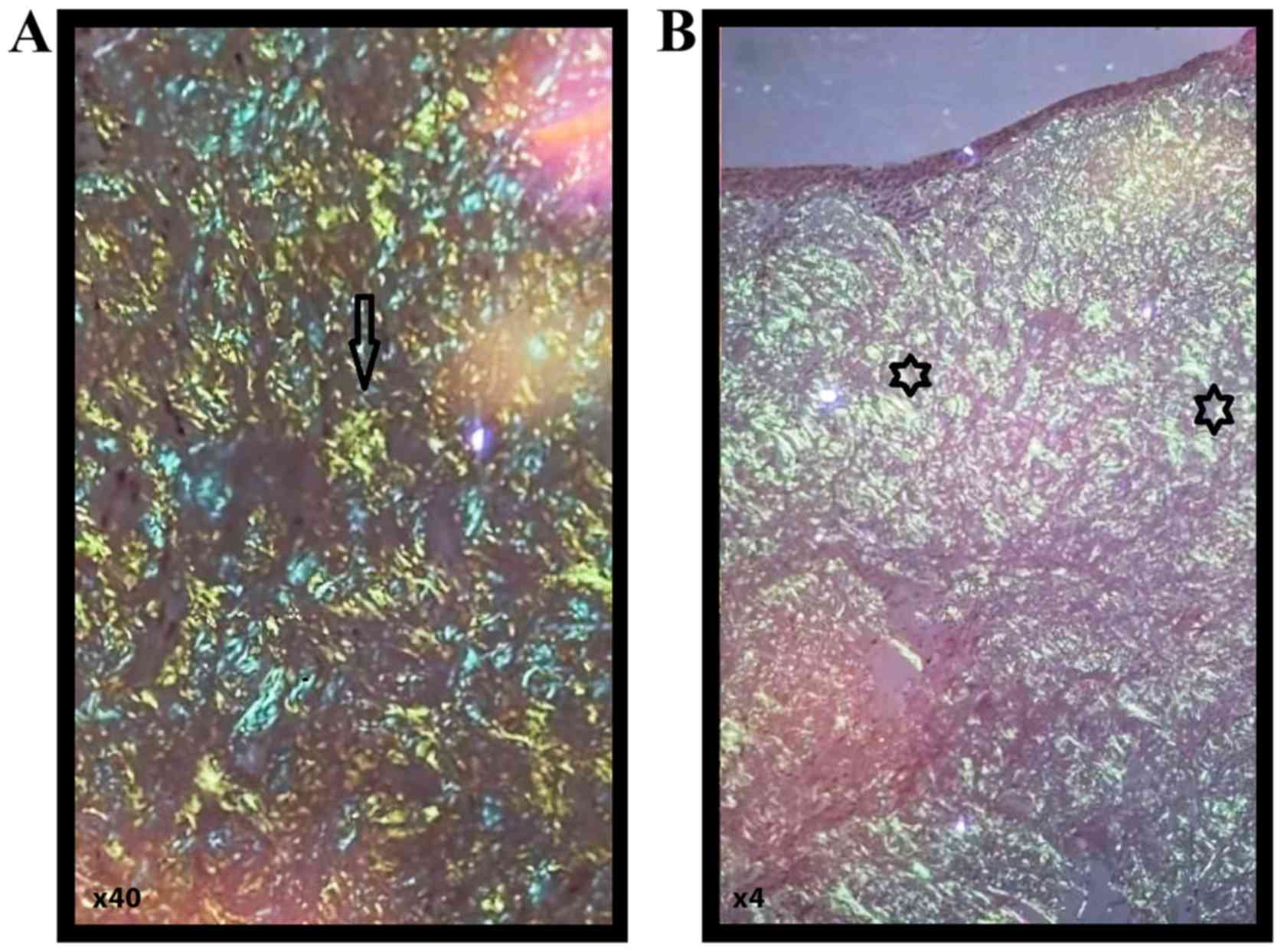|
1
|
Buxbaum JN: The systemic amyloidoses. Curr
Opin Rheumatol. 16:67–75. 2004.PubMed/NCBI View Article : Google Scholar
|
|
2
|
Kerner MM, Wang MB, Angier G, Calcaterra
TC and Ward PH: Amyloidosis of the head and neck. A
clinicopathologic study of the UCLA experience, 1955-1991. Arch
Otolaryngol Head Neck Surg. 121:778–782. 1995.PubMed/NCBI View Article : Google Scholar
|
|
3
|
Westermark P: Localized AL amyloidosis: A
suicidal neoplasm? Ups J Med Sci. 117:244–250. 2012.PubMed/NCBI View Article : Google Scholar
|
|
4
|
Mahmood S, Sachchithanantham S, Bridoux F,
Lane T, Rannigan L, Foard D, Sayed R, Patel K, Fontanna M, Whelan
C, et al: Risk of Progression of localised amyloidosis to systemic
disease in 606 patients over 30 years. Blood. 122(3143)2013.
View Article : Google Scholar
|
|
5
|
van der Wal N, Henzen-Logmans S, van der
Kwast WA and van der Waal I: Amyloidosis of the tongue: A clinical
and postmortem study. J Oral Pathol. 13:632–639. 1984.PubMed/NCBI View Article : Google Scholar
|
|
6
|
Pentenero M, Davico Bonino L, Tomasini C,
Conrotto D and Gandolfo S: Localised oral amyloidosis of the
palate. Amyloid. 13:42–46. 2006.PubMed/NCBI
|
|
7
|
O'Reilly A, D'Souza A, Lust J and Price D:
Localized tongue amyloidosis: A single institutional case series.
Otolaryngol Head Neck Surg. 149:240–244. 2013.PubMed/NCBI View Article : Google Scholar
|
|
8
|
Moon AO, Calamia KT and Walsh JS: Nodular
amyloidosis: Review and long-term follow-up of 16 cases. Arch
Dermatol. 139:1157–1159. 2003.PubMed/NCBI View Article : Google Scholar
|
|
9
|
Biewend ML, Menke DM and Calamia KT: The
spectrum of localized amyloidosis: A case series of 20 patients and
review of the literature. Amyloid. 13:135–142. 2006.PubMed/NCBI View Article : Google Scholar
|
|
10
|
Westermark P, Benson MD, Buxbaum JN, Cohen
AS, Frangione B, Ikeda SI, Masters CL, Merlini G, Saraiva MJ and
Sipe JD: A primer of amyloid nomenclature. Amyloid. 14:179–183.
2007.PubMed/NCBI View Article : Google Scholar
|
|
11
|
Hazenberg BP: Amyloidosis: A clinical
overview. Rheum Dis Clin North Am. 39:323–345. 2013.PubMed/NCBI View Article : Google Scholar
|
|
12
|
Balwani MR, Kute VB, Shah PR, Wakhare P
and Trivedi HL: Secondary renal amyloidosis in a patient of
pulmonary tuberculosis and common variable immunodeficiency. J
Nephropharmacol. 4:69–71. 2015.PubMed/NCBI
|
|
13
|
Berk JL, O'Regan A and Skinner M:
Pulmonary and tracheobronchial amyloidosis. Semin Respir Crit Care
Med. 23:155–165. 2002.PubMed/NCBI View Article : Google Scholar
|
|
14
|
Charlot M, Seldin DC, O'Hara C, Skinner M
and Sanchorawala V: Localised amyloidosis of the breast: a case
series. Amyloid. 18:72–75. 2011.PubMed/NCBI View Article : Google Scholar
|
|
15
|
O'Regan A, Fenlon HM, Beamis JF Jr, Steele
MP, Skinner M and Berk JL: Tracheobronchial amyloidosis. The Boston
University experience from 1984 to 1999. Medicine (Baltimore).
79:69–79. 2000.PubMed/NCBI View Article : Google Scholar
|
|
16
|
Hardy J and Selkoe DJ: The amyloid
hypothesis of Alzheimer's disease: Progress and problems on the
road to therapeutics. Science. 297:353–356. 2002.PubMed/NCBI View Article : Google Scholar
|
|
17
|
Krishnan J, Chu WS, Elrod JP and Frizzera
G: Tumoral presentation of amyloidosis (amyloidomas) in soft
tissues. A report of 14 cases. Am J Clin Pathol. 100:135–144.
1993.PubMed/NCBI View Article : Google Scholar
|
|
18
|
Kubota K, Ito R, Furudate K, Kon T,
Nakagawa H and Kobayashi W: Localized AL amyloidosis of the tongue:
A case report and literature review. J Oral Maxillofac Surg Med
Pathol. 29:142–145. 2017. View Article : Google Scholar
|
|
19
|
Thompson L and Bishop J: Head and Neck
Pathology. 3rd edition. A Volume in the Series: Foundations in
Diagnostic Pathology. Elsevier, 2019.
|
|
20
|
Binmadi N, Intapa C, Chaisuparat R, Akeel
S, Sindi A and Meiller T: Immunophenotyping Oral Amyloidosis for
the Precise Identification of the Biochemical Forms: A
Retrospective Study. Open Dent J. 12:1036–1042. 2018. View Article : Google Scholar
|
|
21
|
Picken MM: Amyloidosis-where are we now
and where are we heading? Arch Pathol Lab Med. 134:545–551.
2010.PubMed/NCBI View Article : Google Scholar
|
|
22
|
Yamagata K and Bukawa H: Oral localised
amyloidosis. In: Amyloidosis - An Insight to Disease of Systems and
Novel Therapies. IntechOpen, London, 2011. https://www.intechopen.com/books/amyloidosis-an-insight-to-disease-of-systems-and-novel-therapies/oral-localized-amyloidosis.
Accessed November 16, 2011.
|
|
23
|
Girnius S: Overview of systemic and
localised amyloidosis. Rev Health Care. 4:231–247. 2013.PubMed/NCBI View Article : Google Scholar
|
|
24
|
Wald MH: Clinical studies of secondary
amyloidosis in tuberculosis. Ann Intern Med. 43:383–395.
1955.PubMed/NCBI View Article : Google Scholar
|













